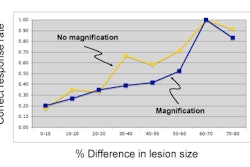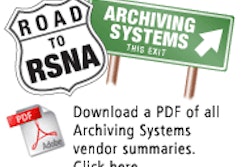SEATTLE - Small imaging centers and radiology practices might not have the human and financial resources of large integrated healthcare delivery networks, but there are ways to overcome the apparent shortcomings and serve referring physicians and the patient population.
Take the case of Scottsdale Medical Imaging in Arizona, a physician-owned practice with 45 subspecialty trained physicians on staff reading for 10 imaging centers and three hospitals over an area of 200 square miles. Its IT system processed approximately 500,000 outpatient exams last year.
When investing in a PACS or other IT infrastructure, Scottsdale must reallocate funds from radiologists' salaries to cover the technology investment. Speaking at this week's Society for Imaging Informatics in Medicine (SIIM) meeting, Scottsdale chief information officer Dr. James Whitfill said it is a "stressful experience" to tell someone to forego a few extra dollars in his or her paycheck to install a PACS. "A radiologist, as you might assume, gets very involved in those decision processes" on how to configure the PACS and what features will be included, he added.
Whitfill cited statistics that the great majority of imaging centers in the U.S. read fewer than 75,000 exams annually without the benefit of a PACS. "The folks who are in these centers are the ones who will be the most constrained by the (lack of) resources," he added.
Subspecialty radiologists
For entities, such as Scottsdale, that do have a PACS, the technology allows them to move into subspecialization. "We can send the studies to the subspecialist radiologist wherever they are located," Whitfill noted. "This is a huge benefit to us. It is also a great benefit to the patients, because giving subspecialized reads creates a better patient care experience."
It also aids in Scottsdale's recruitment of subspecialty radiologists, since subspecialists understandably would prefer to read images they are trained in and not have to read exams that are less familiar.
One advantage that small imaging centers have over larger healthcare delivery networks is that they often do not deal with traditional budget cycles, and don't have a budgetary process or cycle before soliciting for a PACS.
"You are concerned about the total cost of ownership," Whitfill said. "Certainly, that plays into a number of institutions' budget restraints. But for the most part, when we are making a proposal for a group of physicians, they just want to know the net cost over three years, five years, or 10 years."
Advanced imaging
Whitfill does have one gripe about PACS-related technology: the specialized workstation. "We have spent a lot of time and effort over the years trying to get integration into the PACS desktop between the RIS, imaging, and other third-party services," Whitfill said. "Then, all of a sudden, these very expensive stations show up with no integration to anything else and break the workload."
In Scottsdale's decentralized IT configuration, there are instances when the images, the radiologist, and the workstation "are never at the right place at the right time," he added. "If the radiologist happens to be at another site one day, (he or she) doesn't have that kind of workstation there."
Before "we get to buy one of these for every single place a radiologist is going to be, my network guys aren't big fans of this ... because we don't have core backbone. We have to do this complex matrix of DICOM routing throughout the enterprise, duplicating a lot of resending of studies."
'Sole focus on IT'
At Jefferson Radiology, based in East Hartford, CT, assistant director of IT Arne Meis and his staff of 16 full-time equivalent (FTE) IT people support some 45 radiologists reading for seven imaging centers and four hospitals, all in central Connecticut, including the 800-bed Hartford Hospital.
Like many imaging centers of similar size, Jefferson Radiology does not have a great deal of resources compared to larger healthcare systems. "On the imaging side, the advantage that we have is a sole focus on IT," Meis said. "Our IT department is there to make those 45 radiologists very, very happy. We try every day; we struggle every day. Some days we succeed and other days not so much."
Jefferson Radiology has what Meis described as "specialized staffing." For example, there are two RIS/PACS administrators. In a hospital, that singular focus on one IT component might not be possible. Jefferson Radiology also has two FTEs who only work with RIS/PACS, and there is a RIS/PACS associate to help the two administrators oversee the system.
Merging resources
To overcome the lack of human and financial resources, Meis said Jefferson Radiology's lack of bureaucratic red tape and budget committees hastens IT decisions and avoids inaction. He said he has seen such delays with a large tertiary hospital Jefferson Radiology serves. "We have been able to implement things that they have not been able to implement with an IT staff of 100 people," he said. "We were able to set up networks and PACS that they could not get together. Again, probably because of the red tape and some of the processes."
One way or another, Meis strongly advocates that imaging centers have to focus on IT. "Spending has to be within IT to be successful as an outpatient imaging center," he said.
For small imaging centers with limited resources, Meis believes there is strength in numbers. "There is a tremendous opportunity for a very small group of large imaging centers to start getting into some imaging centers that are smaller, buying them, merging with them," he said. "So, to be successful, to push ahead as an imaging center, the focus has to be on IT infrastructure to offer quality service, increase efficiency, and increase patient volume.... Customer satisfaction also will be driven faster with IT and the right resources."
By Wayne Forrest
AuntMinnie.com staff writer
May 16, 2008
Related Reading
New CMS rules alter practices in independent imaging centers, April 8, 2008
Part XIX: Exploring PACS Secrets -- The truth about DRA and PACS, March 27, 2008
Part XVII: Exploring PACS Secrets -- The state of the PACS market, 2008, February 7, 2008
Copyright © 2008 AuntMinnie.com



















